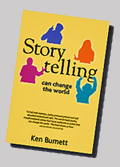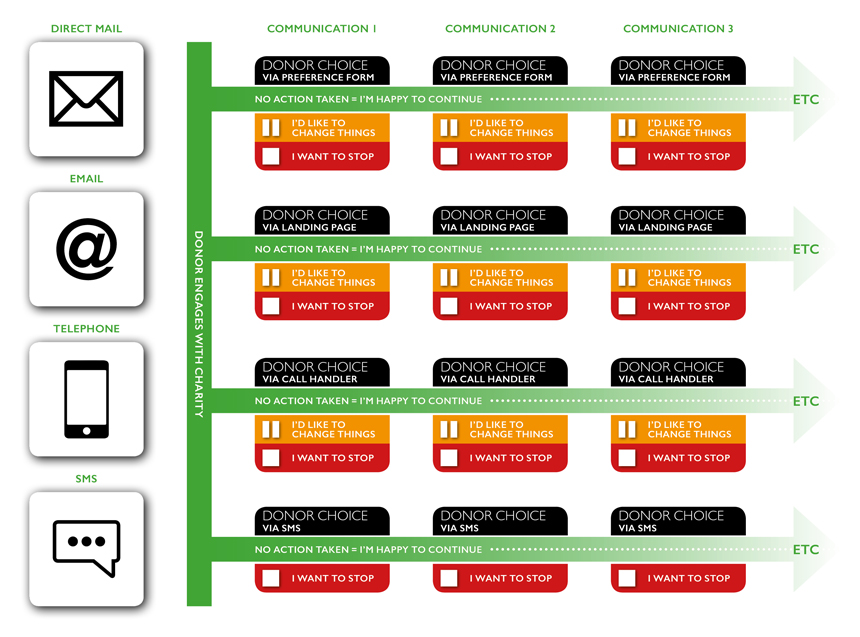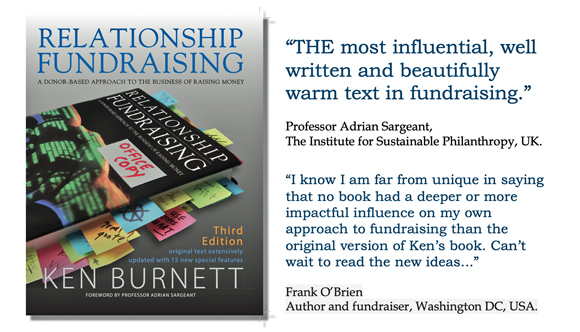| |
Opinion

From Jackie Fowler, chairman of the
Burnett Works agency, 
Tim Connor,
account director at Burnett Works, 
and Ken Burnett,
co-founder of the Commission on the Donor Experience.
Tim and Jackie are joint project owners for project 13 of the Commission on the Donor Experience Managing preferences and giving donors choices.
Blog 10 October 2016.
To restore and consistently promote public trust and confidence, donors now need to be given and to achieve practical control of what they receive from the charities they support, or choose not to support.
Most donors would not wish a perhaps randomly made decision at the start of their relationship with a cause to restrict indefinitely the charity’s ability to contact them, even at a time of crisis or good news.
The welcome information that every donor receives should clearly inform them that they can control everything they are sent from now on, that in every future communication they will be given the opportunity to review their contact preferences
and to change these easily, as the donor wishes, or to leave contact preferences as they are.
Sign up here for FREE notification of future articles
If you’d like to be informed in advance of opinion blogs and stories just type ‘add me to your blog list’ or something similar in the header. You can opt out any time.
 Storytelling can change the World Storytelling can change the World
is reviewed here and here and you can buy it here.
|
|

Think of this as a traffic-light ’permission’ system dictated by the donor and flexible to his or her adjustments at any time.
NB SMS offers no preference choices other than the chance to stop or to continue to receive texts.
CONTINUOUS DONOR CHOICE
FROM THE DONOR’S POINT OF VIEW
How you can keep control of how your favourite charities contact you.
To be a donor to any cause or charity you have to give a first gift. Here’s what’ll happen when you do.
Your gift can be anonymous, which involves nothing more than sending it in.
If you are willing to give the charity your name and address you will be asked to complete your details on a reply form (depending on the medium of communication used this information may be provided via the telephone, by SMS message, via email, or by some other means). Charities always prefer to have your contact details so that they can confirm safe receipt of your donation and tell you about the good things they’ll be able to do now, thanks to your support. And, if you are willing, to engage your future support, appropriately.
Because some see this last point as contentious, charities also want you to be in control of how and when they contact you and what about. So either in this first communication or when you receive an acknowledgement and a letter thanking you for your initial gift you will receive a further reply form which will also contain a number of choices you can make about how you would like the charity to communicate with you in the future, specifying how often, on what subjects and when you’d be willing for the charity to make contact. And even if you’d prefer the charity not to contact you at all.
The choices you’ll be offered include.
• Whether you want to receive the charity’s news for supporters. This will tell you about what the charity has done with the donations it receives and the kinds of difference your gift will make.
• Whether you wish to receive the charity’s regular appeals (most charities usually send four or more postal appeals each year, though this does vary from charity to charity).
• Whether you’d prefer to receive just one appeal each year. This will usually be sent in the period before Christmas but you might also be asked when might be the best time for you to receive that appeal.
• The charity might ask how you’d prefer to hear from them, for example by post, by telephone, by email, or by text to your mobile phone. Or, if you prefer, by none of these routes.
• Sometimes you’ll be offered choices on the kinds of information that you can receive, as well as the frequency. For example, information on certain selected projects, or detailed feedback on a project that interests you, or where your gift has made a difference.
• If you prefer not to receive any appeals you will always have the chance to opt out of further communication from the charity. Or to opt back in if you’d like to receive more. The choice is yours, always.
From now on each time that you hear from the charity (based on the choices you made earlier) you will be given the chance to change your preferences as you wish. So you will always be in control.
These or similar choices should be available to you whenever you hear from any charity, even if you’ve never supported that charity before. The charity will always respect your rights to the details you have supplied and will not sell, pass on, or alter your personal data without your permission.
• Other choices may be offered, depending on the capacity of the individual charity and the range of choices they wish to offer their donors.
Enjoy being a donor!
* *
Related links/earlier blogs:
• Back to main article.
• Donor-centred fundraising – are you prepared to take a leap of faith?
• A donor preference service that works, from the 1980s.
• Botton Village: giving donors choices.
• Botton Village: the Frances pack. * *
Home page | Current blogs | Article archive

|





